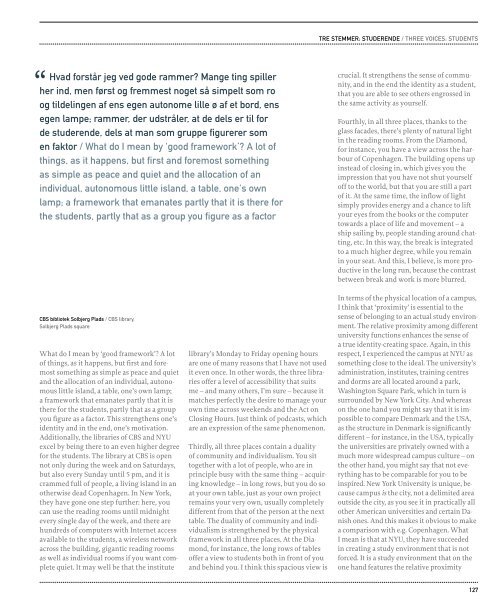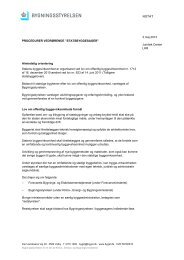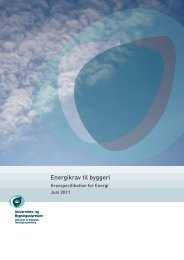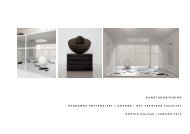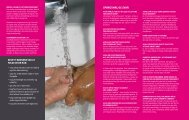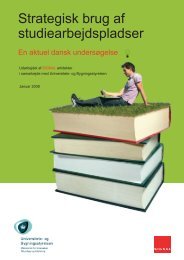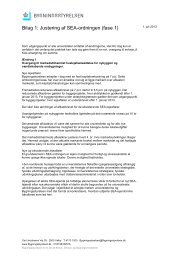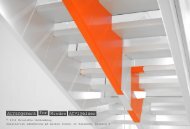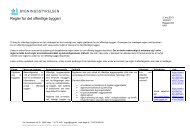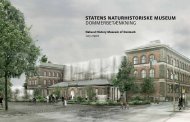Campus og studiemiljø - Bygningsstyrelsen
Campus og studiemiljø - Bygningsstyrelsen
Campus og studiemiljø - Bygningsstyrelsen
Create successful ePaper yourself
Turn your PDF publications into a flip-book with our unique Google optimized e-Paper software.
“ Hvad forstår jeg ved gode rammer? mange ting spiller<br />
her ind, men først <strong>og</strong> fremmest n<strong>og</strong>et så simpelt som ro<br />
<strong>og</strong> tildelingen af ens egen autonome lille ø af et bord, ens<br />
egen lampe; rammer, der udstråler, at de dels er til for<br />
de studerende, dels at man som gruppe figurerer som<br />
en faktor / what do i mean by ‘good framework’? a lot of<br />
things, as it happens, but first and foremost something<br />
as simple as peace and quiet and the allocation of an<br />
individual, autonomous little island, a table, one's own<br />
lamp; a framework that emanates partly that it is there for<br />
the students, partly that as a group you figure as a factor<br />
CBs bibliotek solbjerg plads / CBs library,<br />
solbjerg plads square<br />
What do I mean by ‘good framework’? A lot<br />
of things, as it happens, but first and foremost<br />
something as simple as peace and quiet<br />
and the allocation of an individual, autonomous<br />
little island, a table, one’s own lamp;<br />
a framework that emanates partly that it is<br />
there for the students, partly that as a group<br />
you figure as a factor. This strengthens one’s<br />
identity and in the end, one’s motivation.<br />
Additionally, the libraries of CBS and NYU<br />
excel by being there to an even higher degree<br />
for the students. The library at CBS is open<br />
not only during the week and on Saturdays,<br />
but also every Sunday until 5 pm, and it is<br />
crammed full of people, a living island in an<br />
otherwise dead Copenhagen. In New York,<br />
they have gone one step further: here, you<br />
can use the reading rooms until midnight<br />
every single day of the week, and there are<br />
hundreds of computers with Internet access<br />
available to the students, a wireless network<br />
across the building, gigantic reading rooms<br />
as well as individual rooms if you want complete<br />
quiet. It may well be that the institute<br />
library’s Monday to Friday opening hours<br />
are one of many reasons that I have not used<br />
it even once. In other words, the three libraries<br />
offer a level of accessibility that suits<br />
me – and many others, I’m sure – because it<br />
matches perfectly the desire to manage your<br />
own time across weekends and the Act on<br />
Closing Hours. Just think of podcasts, which<br />
are an expression of the same phenomenon.<br />
Thirdly, all three places contain a duality<br />
of community and individualism. You sit<br />
t<strong>og</strong>ether with a lot of people, who are in<br />
principle busy with the same thing – acquiring<br />
knowledge – in long rows, but you do so<br />
at your own table, just as your own project<br />
remains your very own, usually completely<br />
different from that of the person at the next<br />
table. The duality of community and individualism<br />
is strengthened by the physical<br />
framework in all three places. At the Diamond,<br />
for instance, the long rows of tables<br />
offer a view to students both in front of you<br />
and behind you. I think this spacious view is<br />
tre stemmer: studerende / tHree voiCes: students<br />
crucial. It strengthens the sense of community,<br />
and in the end the identity as a student,<br />
that you are able to see others engrossed in<br />
the same activity as yourself.<br />
Fourthly, in all three places, thanks to the<br />
glass facades, there’s plenty of natural light<br />
in the reading rooms. From the Diamond,<br />
for instance, you have a view across the harbour<br />
of Copenhagen. The building opens up<br />
instead of closing in, which gives you the<br />
impression that you have not shut yourself<br />
off to the world, but that you are still a part<br />
of it. At the same time, the inflow of light<br />
simply provides energy and a chance to lift<br />
your eyes from the books or the computer<br />
towards a place of life and movement – a<br />
ship sailing by, people standing around chatting,<br />
etc. In this way, the break is integrated<br />
to a much higher degree, while you remain<br />
in your seat. And this, I believe, is more productive<br />
in the long run, because the contrast<br />
between break and work is more blurred.<br />
In terms of the physical location of a campus,<br />
I think that ‘proximity’ is essential to the<br />
sense of belonging to an actual study environment.<br />
The relative proximity among different<br />
university functions enhances the sense of<br />
a true identity-creating space. Again, in this<br />
respect, I experienced the campus at NYU as<br />
something close to the ideal. The university’s<br />
administration, institutes, training centres<br />
and dorms are all located around a park,<br />
Washington Square Park, which in turn is<br />
surrounded by New York City. And whereas<br />
on the one hand you might say that it is impossible<br />
to compare Denmark and the USA,<br />
as the structure in Denmark is significantly<br />
different – for instance, in the USA, typically<br />
the universities are privately owned with a<br />
much more widespread campus culture – on<br />
the other hand, you might say that not everything<br />
has to be comparable for you to be<br />
inspired. New York University is unique, because<br />
campus is the city, not a delimited area<br />
outside the city, as you see it in practically all<br />
other American universities and certain Danish<br />
ones. And this makes it obvious to make<br />
a comparison with e.g. Copenhagen. What<br />
I mean is that at NYU, they have succeeded<br />
in creating a study environment that is not<br />
forced. It is a study environment that on the<br />
one hand features the relative proximity<br />
127


